NEONATOLOGY ON THE WEB
The Nursling
Lecture 2
By Pierre Budin, Professor of Obstetrics, University of Paris; Director
of the Clinique Tarnier; Member of the Academy of Medicine, Paris, France. Authorized
translation by William J. Maloney, M.B., Ch. B., 1907.
Gentlemen,
In our last lecture I spoke to you of weaklings, i.e.
infants born before term. I showed you how important it was to pay
great attention to their temperature; I pointed out how rapidly they
became chilled; and I also impressed upon you that cold could
injuriously effect the better-developed and more resistant full-term
child.
Yesterday, we had a striking example of this. A mother, delivered
here several weeks ago, wished, in spite of the cold, to bring her
infant to the Consultation. She was extremely anxious to have our
advice, as after ten pregnancies this was her only living child. She
came from the outskirts of Paris. On arrival, the infant had a sort
of cold stroke; it was dyspnoeic, cyanosed, and had a rectal
temperature of 35° C. It was rubbed, put in a hot bath, and
gradually it revived. It was cared for in the hospital till it had
thoroughly recovered, and every precaution was taken to obviate
chilling on the homeward journey.
If such serious symptoms can arise in a full-term child of several
weeks, from an exposure to cold, it is easy to realise how frequent
and fatal is the chilling of premature infants.
The temperature of weaklings must, therefore, be maintained at
normal. Thanks to the use of incubators, hot baths, and other means,
this may be done; but it is not the only essential. A living being
must generate heat. The infant must produce its own animal heat, and
we must provide it with fuel by giving it food.
You know what takes place. Food is introduced into the alimentary
canal, and there modified by the various digestive juices.
The products pass into the blood and lymphatic vessels of the
intestine, and thence are carried to the right side of the heart by
the inferior and superior venae cavae.
The blood containing the assimilated food-stuffs is sent to the
lungs, where it obtains oxygen from the air, and then it returns to
the left side of the heart to be propelled throughout the body.
In the midst of the tissues the food-stuffs are brought into
intimate relation with the oxygen, and combustion takes place, with
the production of heat. To generate animal heat two things are thus
necessary: (1) oxygen; (2) substances which can be oxidised, or burnt
up in the economy. This entails not only a pulmonary apparatus
capable of functioning, but also a digestive tube capable of
rendering nutritive materials assimilable.
How are these different functions performed in infants born long
before term?
There is no doubt that in those who come into the world after only
six or seven months of intra-uterine life, the various organs are not
fully developed. Respiration at the beginning is purely bronchial,
and as it is only little by little that air penetrates into the
pulmonary alveoli, the blood is at first imperfectly oxygenated. In
the digestive apparatus, the salivary and gastric glands, the liver,
pancreas, and intestinal villi are also, probably, incompletely
developed. At present, the actual structure of these various organs
is still under investigation, and is a very interesting field for
anatomical research.
How do the substances elaborated by these embryonic glands act on
the food which the weakling ingests? Here, again, is considerable
scope for research. What I have said, however, suffices to show you,
that an infant born before term is not very fit to carry on the work
of digestion and assimilation essential to the generation of its
animal heat.
To say that the newly born is only a digestive tube is certainly
to exaggerate. Nevertheless, the importance of the alimentary tract
must not be underestimated, for, if digestion and assimilation are
not properly performed, the gravest of symptoms, even death itself,
may result.
Let us, then, see how infants born prematurely, congenitally
feeble, ought to be fed.
Almost from the time I undertook the direction of the department
for weaklings at the Maternité, I was greatly impressed not
only by the facility with which they became fatally chilled, but also
by a curious clinical phenomenon of which, till then, I had had
little experience. I observed that a few days after their admission
infants frequently had attacks of cyanosis. They suddenly became
blue, as if part of the milk they had taken had passed into their air
passages, and was choking them. If assistance was not immediately
rendered, they died. If, however, energetic measures were promptly
taken, they usually revived, although many succumbed to subsequent
attacks.
In searching for the possible cause of these cyanotic attacks, I
noticed that, as a rule, infants, in whom they occurred, were
underfed.
In order to find the amount of food taken by weaklings, they were
weighed before and after each meal, and the difference between the
two weights showed how much milk had been swallowed. This was marked
on a card, and it was only necessary, at the end of the twenty-four
hours, to add up these differences to ascertain what quantity had
been taken throughout the day. Obviously, there may occasionally be
some difficulty in giving a fixed quantity at each meal, but it can
be done to within a few grams.
It was thus easy for me to prove that, in general, infants
attacked by cyanosis were insufficiently nourished. Here, for
example, is the history of a weakling brought to the
Maternité, in 1895, and registered as No. 194. It was born in
Paris on May 30, and carried to us the same day. On admission, it had
a rectal temperature of 34.9° C., and weighed 1930 grams.
On the sixth day it vomited a little; on the eighth, June 7, it
had cyanotic attacks, which recurred on the following days. The
infant took very little nourishment, and it was impossible to
increase the quantity, for it continued to reject most of the milk
given. On the sixteenth day the vomiting ceased, and with it the
cyanotic attacks (Fig. 8). During the
succeeding days the quantity of milk was increased, but on the
twenty-first day the cyanotic attacks again appeared. Under the
circumstances, the amount absorbed was, perforce, insufficient, and
as is seen, on Fig. 8, the quantity of
milk ingested was less than that which is indicated by the dotted
line, representing the amount which ought normally to have been
taken.
The vomiting ceased at last on the thirty-sixth day. On the
thirty-seventh, there was still some cyanosis, but from this date we
were able to greatly augment the supply of milk, until we even
surpassed the average amount. The infant had no further attacks. It
began to grow regularly, and on August 9 left hospital in good
health, weighing 2600 grams.
Among my other cases of this affection, there is one with an
equally interesting history, for, as it was brought to me in summer,
it is impossible to attribute its cyanotic attacks to cold. Born on
June 24, 1895, it was admitted on July 3, and registered as No. 231.
It had, on entry, a rectal temperature of 36.7° C., and weighed
2290 grams. This infant was nourished by its mother. On arrival at
the Maternité it had an attack of cyanosis, and others
occurred on the following days. It was vomiting, but its stools were
yellow. It was receiving insufficient nourishment, as is seen on the
curve of the quantities it took (Fig.
9). It soon ceased to vomit, and from July 10, seven days after
admission, we were able to increase the doses of milk. The cyanotic
attacks disappeared, with the exception of two slight relapses on the
tenth day. The infant took more and more each time it was put to the
breast. On July 28 it left the hospital, with a weight of 2650 grams,
and the mother continued to suckle it.
On August 3 it was brought back, again suffering from attacks of
cyanosis. It was not taking the quantity of milk we had laid down as
its normal; instead of 560 to 600 grams it was ingesting only from
410 to 490 grams. More was given, and the cyanotic attacks ceased.
The infant left, again in good health, on August 13, weighing 3030
grams.
I am convinced by such cases that cyanotic attacks may arise from
underfeeding; and if this origin be proved in any particular
instance, then, sufficient food should be given, and, provided
vomiting does not interfere with assimilation, the attacks will
cease.
What ought to be your treatment in cases of cyanosis in weaklings?
The first thing to do is to put them in a glass incubator.
I insist on the use of this kind. It is pleasing to the eye; the
little inmate is never hidden from the mother's anxious sight; but
above all, it facilitates the thorough and unremitting supervision by
day and night which these cases demand, for where one attack of
cyanosis has occurred the chances are that there will be a second.
When an attack takes place the weakling must be lifted out of its
incubator, and everything tried to bring about the re-establishment
of the respiration. It should be undressed, and friction applied to
the limbs and trunk. Too great force must not be used for fear of
injuring the delicate abdominal organs, especially the liver.
Rhythmic pressure should be made on the thoracic walls, and if the
mouth contains any mucous, it should be cleared out. Sometimes it is
of service to hold the infant up by the legs, head downwards, so as
to determine an afflux of blood to the brain, and I have had recourse
with success to insufflation in a few cases. When breathing
recommences the infant is plunged into a hot or a stimulating bath.
After it has fully recovered, it is put back into the incubator.
Oxygen, supplied through a funnel, the large opening of which is
placed beside the infant's face, may then be used with advantage.
Afterwards, it is necessary to supervise the feeding with a view
to increasing the amount absorbed. If the child does not wish to take
the breast, or is not strong enough to suck, it must be fed from a
spoon, and if it cannot swallow, gavage [feeding by stomach tube]
must be employed.
Sometimes vomiting is present, which forms a very embarrassing
complication. We must then give only a small quantity of milk at a
time, and compensate by feeding every hour and a half or every hour.
Food thus given in small bulk is retained and digested more easily.
I have sometimes given potassium bromide. It is of value when
gavage is necessary, as it decreases the sensibility of the pharynx.
A solution is made, which ought to be used within twenty-four hours,
containing 20 centigrams of bromide, the amount which can be
administered to an infant weighing about two kilograms.
These are the various measures which I have found useful in the
treatment of weaklings attacked with cyanosis. Sometimes in spite of
all, they die very quickly, but often they are happily saved. The
struggle may be long and anxious; in one of the cases I have just
cited, four weeks elapsed before success was assured. So never
despair.
I have shown you, gentlemen, that infants attacked with cyanosis
need more food. When I first proposed to increase their ration, I ran
counter to the opinion of my predecessors in the wards, who held that
if more was given than these infants wished to take, digestive
disturbances would arise and probably cause death. "But," I reasoned,
"these infants have cyanosis, and one thing is certain, they will die
if they are not adequately fed. Is this fatal diarrhoea inevitable? I
think not, and, at any rate, it is far better to try to do something
than to abandon them to their fate for fear of the visionary risks of
treatment."
Perhaps you remember the refrain of an old song:
... "puis qui'il nous faut mourrir
Suivons, au moins, le chemin du plaisir."
In this case, the path of pleasure, for adults, is drinking. May
it not be the same for infants? I increased their absorption of milk
with, as you have seen, the happiest of results.
You must not think I was giving these infants an excessive diet, I
raised their ration only to sufficiency. I wish you to be quite clear
on this point, for nothing is further from my thoughts than the
advocacy of overfeeding, the scourge of infancy. In the wards, you
will often see infants put to the breast at every moment of the day
and night. They rapidly swallow large quantities of milk, and at the
end of each twenty-four hours the weighings show that they have taken
far too much. We are forced to keep them apart from their mothers. We
allow them to suck only at stated intervals, and for a few minutes at
a time. Under this dieting any digestive troubles disappear,
diarrhoea ceases, and the infant's weight increases normally. Only
this morning, you saw a woman weeping in the wards because her
infant, overfed, and, in consequence, indisposed, had to be separated
from her. Weaklings are more readily affected by excessive diet than
full-term infants. Let me give you a typical case.
An infant, No. 157, born on March 11, 1895, was brought to the
Maternité on March 26, with a weight of 2120 grams. This
weakling, who has a fine curve (Fig.
10), was a source of great concern to me for some time; its
stools were liquid, almost quite green, and only partially digested.
It increased in weight, but its digestion remained far from good. At
the bottom of the figure, you will see the total amount of milk it
took each day. This greatly surpassed that which it should normally
have absorbed, according to its weight, and which you see indicated
by the dotted line. Little by little, however, I reduced the amount
to what it should have been, and the stools gradually improved.
These overfed infants suffer from indigestion and diarrhoea, and
they very quickly lose weight. It is only by careful dieting that
their digestive tube can be restored to a healthy state.
You see in what a predicament you may be! If too little be given,
there is the danger of inanition, cyanotic fits, and death; if too
much, there is the dread of digestive troubles, which may also prove
fatal. The two extremes, overfeeding and underfeeding, must be
avoided, so the average quantity of milk for an infant has to be
ascertained.
With a view to establishing this average the post-mortem capacity
of infants' stomachs, at various periods of intra-uterine life, has
been estimated, but this method does not seem to me to be reliable;
the walls of the stomach are not inextensible, and after death the
organ may be found dilated even when empty.
I have proceeded on a different plan. Every day the quantity of
milk taken at each meal by weaklings at the breast was observed: for
infants, who for various reasons were not suckled, what was
introduced by gavage or otherwise was noted. A simple addition
enabled the total quantity taken in twenty-four hours to be thus
ascertained.
I accumulated a large number of such observations relating to
infants of known weight, taking the quantity of milk sufficient for
their normal development. They presented neither cyanosis nor
diarrhoea. Their weight increased regularly and adequately, and their
daily temperature was normal.
My method, then, was based purely on clinical observation
reinforced by the balance and thermometer.
In the days immediately following their birth weaklings do not
take much milk, but the amount increases day by day. From the ninth
or tenth day, however, it augments relatively at a much slower rate,
so it is necessary to distinguish between --
A. Infants during their first ten days.
B. Infants after their tenth day.
A. During the initial ten days of a weakling's life, when all goes
well, the weight at first diminishes, then remains stationary, and
finally increases.
The quantity of milk ingested becomes progressively greater: quite
inconsiderable at the beginning, it augments more and more as the
days go on. Since it varies with the infant's weight, I have divided
them into three categories:--
1. Infants weighing between 1350 and 1800 grams.
2. Infants weighing between 1800 and 2200 grams.
3. Infants weighing between 2200 and 2500 grams.
Of those in the first category I have 11 observations.
Of those in the second category I have 31 observations.
Of those in the third category I have 25 observations.
In the following table the average quantities taken each day are
reproduced:--
|
|
1. Infants weighing less than 1800 grams
|
Infants weighing from 1800 to 2200 grams
|
Infants weighing from 2200 to 2500 grams
|
|
|
11 infants
|
31 infants
|
25 infants
|
|
2nd day
|
115 grams
|
128 grams
|
180 grams
|
|
3rd day
|
160
|
175
|
236
|
|
4th day
|
210
|
226
|
295
|
|
5th day
|
225
|
308
|
335
|
|
6th day
|
250
|
324
|
370
|
|
7th day
|
280
|
335
|
375
|
|
8th day
|
285
|
350
|
385
|
|
9th day
|
310
|
380
|
415
|
|
10th day
|
320
|
410
|
425
|
In each category, the quantity of milk absorbed by the infant is
seen to augment from the second to the tenth day. It is greater for
infants in the second category than in the first, and in the third
than in the second.
This is quickly seen on looking at the three tracings at the foot
of Fig. 11, where the quantities of
milk are indicated.
On the same figure, I have placed above each of the tracings of
the quantity of milk the weight curve of an infant belonging to the
corresponding category.
To represent infants weighing between 1350 and 1800 grams, I have
taken the curve of a weakling, No. 662, born at the Clinique Tarnier
on May 15, 1898, with a weight of 1690 grams. It was carefully
guarded from cold, and it left hospital on June 14, weighing 2050
grams.
For the second category, between 1800 and 2200 grams, the curve is
that of an infant born at the Clinique Tarnier, on November 22, 1898;
it then weight 2030 grams. By the tenth day it had attained 2130
grams, by the twelfth 2190, and by the twenty-third, when the mother
wished to leave, 2475 grams.
In the third category is found the curve of an infant born on
October 31, 1898, weighing 2270 grams; it was kept warm, and it had a
very fine curve (see also Fig. 17).
If these three curves be compared, it will be seen that that of
the infant in the first category, after its initial fall, has but
tardily begun to rise, and has made a slow ascent. The curve of the
infant in the second category has commenced to mount sooner, and has
risen more rapidly. That of the infant in the third category has
risen still earlier, and has progressed still more rapidly.
When infants are smaller than those in our first category, their
weight is seen to fall lower; their curve remains longer stationary,
and mounts even more slowly. This was well shown by an infant born on
April 21, 1898, with a weight of 1270 grams
(Fig. 6, p. 16). On May 1, it weighed
1070 grams, a loss of 200 grams in ten days. On May 31 its weight was
1550 grams, an increase of only 480 grams in thirty days. On December
22, 1898, it weighed 4800 grams.
The conclusion that follows from these observations is that little
milk should be given to a weakling during the first days of its life,
but that the quantity should be increased progressively and according
to the weight of the infant, in the proportions indicated on the
table of the category to which it belongs.
It is possible thus to avoid, on the one hand, the fatal
consequences of inanition and cyanosis, and, on the other, digestive
disturbances and diarrhoea, caused respectively by insufficient and
excessive feeding.
When infants are very tiny, they absorb only small quantities at
each meal. In rare cases, it may be of service to make them drink
every hour and half, so that at the end of twenty-four hours they
will have ingested the amount adequate to their needs.
When infants are feeble, they sometimes refuse to suck. Milk is
then made to trickle into their mouths, directly from the nipple, by
exerting pressure upon it, or they are fed from a small spoon, till
they become strong enough to take the breast; but, if they allow the
milk to dribble out of their mouths, if they do not swallow, or if
they reject what is given to them, gavage, feeding by the stomach
tube, must be considered.
In March 1884, Tarnier began to practice gavage methodically, but,
in 1851, Marchant of Charenton advocated and described the procedure,
and his example was followed by Legroux in 1860, Rizzoli in 1861,
Fabri in 1865, and Belluzi in 1870.
The instrument which Tarnier employed was a miniature of that used
by Faucher and Debove for washing out the stomach in adults. In 1866
I devised a small instrument for the purpose. It has a glass capsule
graduated to 15 cubic centimetres, which enables one exactly to
measure the quantity of milk introduced into the stomach
(Fig. 12). With this apparatus nothing
is easier than to gavage an infant. Tarnier thus describes the
manipulation: "The tube, having been moistened, is introduced as far
as the base of the tongue. After the infant, by instinctive
movements, has caused it to enter the oesophagus, it is gently pushed
on, till, having traversed a course, including the mouth, of about 15
centimetres, it reaches the stomach. When the tube has been
compressed between the fingers, the nutritive fluid is poured into
the capsule, and then, on the pressure being released, the liquid, by
virtue of its weight, penetrates to the stomach. The instrument is
then withdrawn, but if this is not done by a rapid movement, the
nutritive food will follow, and be rejected."
We have seen the quantity of milk which must be given to a
weakling during the first ten days; but, how much should it take
subsequently. When it does not receive enough, its curve, instead of
continuing to rise, forms a plateau. If, after assuring ourselves
that the digestive tube is quite healthy, and that no pathological
condition is present, we augment the quantity of milk, the infant's
weight at once increases, and its curve ascends.
Here is, for example, an infant, No. 88, born on February 12,
1895, and admitted on February 17. It then weighed 2390 grams. At
first, owing to the passage of the residue of meconium, it lost
weight. Then it began to gain, but after a time, it was found to have
become stationary; in four days it had increased by only 20 grams. It
was taking a quantity of milk below the proper average for its age:
this average is represented by the dotted line on
Fig. 13. It was made to take 70, 100,
and 120 grams more, and it began at once to put on weight. I should
add that it was suckled the whole time by the same wet-nurse.
If, then, an infant does not increase, and you find the functions
of the digestive tube being properly performed, but the quantity of
milk insufficient, give it more, and its curve will at once begin to
mount regularly.
There is a remark to which I attach very great importance, and
which I must not omit. If an infant does not take quite enough, it
remains stationary. It has no digestive disturbances; its stools are
rare, perhaps, but they are perfectly yellow. If more be given,
assimilation is rapid, and the weight quickly increases. This
observation applies not solely to weaklings, but also to full-term
infants, and even to children who weigh five or six kilograms, or
more. It is therefore far better at first to give infants too little
than too much. If they take too great a quantity, they will assuredly
have diarrhoea, and time will be taken up in restoring their
alimentary canal to a healthy state.
B. By the observation of many infants, I have been able to fix
approximately the quantity of milk, necessary after the tenth day,
for those who weigh about 2000 grams, between 1800 and 2500 or 2600,
for example. Judging from a great number of facts, which are
graphically recorded in the curves I am about to show you, I think
that we can find a means of estimating this quantity quickly and with
sufficient accuracy.
Let us take, for example, an infant of 2000 grams. Suppress the
last nothing, 200 is left. Multiply this figure by two, 200 X 2 =
400; that is to say, about 400 grams of human milk ought to be given
to an infant of two kilos. I say about, for, as a rule, more
is needed. Give, then, 400 grams, with a small quantity -- 20, 30, or
40 grams -- in addition, always provided that the alimentary tract is
healthy, and you will find that such infants under your care will
steadily increase.
Let us take as another example an infant of 2500 grams. Suppress
the last nothing, you have 250. Multiply this number by two, 250 X 2
= 500.
You ought to give this infant 500 grams of milk plus a small
amount, which will vary according to certain conditions, such as the
quality of the milk and the assimilative powers of the digestive
tube.
It is by the accumulation of many observations that I have arrived
at these figures. I must tell you at once, they are true only for
infants weighing about 2000 or 2500 grams. They are no longer
applicable above 2800 grams, as infants over this weight take a
quantity relatively smaller. If, for example, an infant weighed 4000
grams, I would not say it ought to receive 800 grams of milk. This
would be altogether too much. These figures, therefore, apply only to
healthy weaklings, weighing between 2000 and 2500 grams, and larger
infants require proportionally less.
The weakling thus requires an amount slightly more than one-fifth
of its body weight. Consequently, if its weight be divided by five,
the result will be the quantity of milk it should absorb. An infant
of 2000 grams would take a little more than 2000 / 5, i.e. a
little more than 400 grams.
Here are several cases in support of these figures.
The first is that of an infant (admission number 116) born on
February 14, 1895, and brought to the Maternité on March 2. It
was given what we have indicated as the average quantity of milk.
This amount is represented in Fig. 14
by the dotted line. The exact quantity absorbed each day is shown by
the blue columns. The infant increased regularly: its stools were
yellow and of normal consistence. Sixteen days after its admission it
was taking a little more than this amount. It continued to assimilate
well and to augment steadily. In ten days it gained nearly 400 grams,
an average of 40 grams per day.
Another infant, born on July 8, 1895, was admitted on July 9, and
registered as No. 246. It weighed 1440 grams. After the usual initial
fall, it began to increase. Its curve
(Fig. 15) indicates its progress from
week to week and not from day to day. The quantity of milk taken from
the tenth day closely follows the dotted line, which represents what
we have laid down as the normal. The infant left hospital in
excellent health on September 16, weighing 2990 grams.
Obviously these figures constitute only an average, and have but a
relative value. It is necessary to take into account the state of the
alimentary tract, the weakling's powers of assimilation, and also the
quality and composition of the milk.
There are some infants who take larger quantities and thrive. So
long as their digestive tube functions well, one can afford to wait.
For example, an infant was born in Avenue Carnot, on January 1, 1898,
weighing 2180 grams. At the beginning it lost weight, then it began
to gain. On examining its curve (Fig.
16) you will see that from the tenth day it took much more than
the average, till it reached an excess of 100 grams. Its alimentary
tract was acting perfectly, so I did not interfere. It increased 700
grams in seventeen days, an average of 40 grams per day.
This weakling was in charge of a wet-nurse, who also suckled her
own infant. She made the nursling feed first, so he took the milk
less rich in butter, and hence was able to digest a great deal of it
without disagreeable consequences.
Other infants, on the contrary, take less than our normal and
still augment regularly. This is because the milk ingested contains
excess of fat, and thus is more nourishing in smaller volume.
The infant D_____, born prematurely on October 31, 1898, weighed
only 2270 grams (Fig. 17). After the
initial descent it had a rapid rise. It was fed by a wet-nurse, who
also suckled her own child, an infant three months old. You see on
the tracing that for a certain time Baby D_____ took a quantity of
milk barely equal, or even inferior, to the average we have laid
down. On the eleventh day, for example, when it weighed 2440 grams,
it absorbed only 400 grams; but the wet-nurse was suckling her own
little one first, so that the nursling was taking the last of the
milk, which was very rich in butter; an analysis showed it contained
51.55 grams of butter per litre, instead of 35, nearly half as much
again as normal milk. From the point of view of butter, therefore, it
was the same as if the infant had taken 600 grams and not 400. All
was not being assimilated. The motions were copious, and contained 35
per cent. of fat instead of 20; they were badly digested and
sometimes also liquid. Thus, although taking less than the average,
this infant was increasing greatly, for he was receiving a very rich
milk.
The quantities have therefore only a relative value. If the milk
be poor in butter, the infant may absorb a larger quantity without
danger; if, on the contrary, it be rich in fat, the infant ought to
take less, otherwise the excess appears in the stools, and troubles
arise from the alimentary tract.
To put it briefly, you will give to an infant a quantity of milk,
determined in accordance with its weight, but varying more or less in
proportion to the richness of the milk in fat.
Here is an observation which emphasizes the importance of the
quality of the milk. An infant, No. 237, born on January 21, 1895,
was received on February 16, 1895, weighing 1820 grams. At the
beginning he had a very good wet-nurse, whom we shall call A, who was
giving him only a little milk, between 400 and 500 grams per day;
with her the infant's curve rose regularly. This wet-nurse had to
leave. She was replaced by another, B, from whom the infant drank
greater quantities; he was now absorbing 500-600 grams, 100 grams
more than he had taken from A, and yet he was stationary. His curve
formed a plateau during the whole of this period. A third wet-nurse,
C, was given to him; at first she gave the same quantity of milk as
B, but the infant increased considerably one more
(Fig. 18). Later, having a greater
weight, he required more.
Here, then, was a healthy infant whose digestive tube was
functioning well. He had three wet-nurses in succession; his
digestive tube remained unaltered. With the first, who had an
excellent milk, he increased considerably; with the second, although
he took more, he remained stationary; whilst with the third, although
at the beginning he absorbed the same quantity as he did from the
second, he had again a very fine curve. You see, therefore, the great
importance of the quality of the milk.
Lastly, there is another matter to which I wish to refer. Infants
are sometimes brought suffering from diarrhoea. These are little
ones, already born some time, who have been badly fed. Some have
taken too much, and others have absorbed cow's milk of bad quality,
or injurious food preparations. They are often dangerously ill, and
our first care is to put their alimentary canal in order.
On July 18, 1896, an infant, No. 193, was brought to us. It had
been born on June 19. Its rectal temperature was 35° C., and its
weight 2290 grams. It had diarrhoea and vomiting; its stools were
copious and green, and its buttocks erythematous. As may be seen on
Fig. 19, the infant was put on a
reduced diet; albumen water and milk were given, and some intestinal
antiseptics were prescribed. The diarrhoea with green stools
persisted several days; then the motions, still liquid, became more
yellow. The infant continued to lose weight until August 5, and the
quantity of milk taken was almost uniformly below normal. The motions
became of good consistence. Assimilation was being properly performed
once more; and the infant, thus cured, began to increase in weight.
The quantities of milk ingested soon rose to the average, and even
surpassed a little the line corresponding to one-fifth of its body
weight.
Here is another example: An infant, No. 215, born on July 13,
1897, was brought to the Maternité on August 28, weighing 2890
grams. It was not a weakling in the proper sense of the term; it was
not affected with congenital debility, but it was enfeebled from an
attack of enteritis. The stools were green, and for some days the
temperature oscillated between 39° and 40° C. It was cared
for, put on an appropriate diet, and at the end of eighteen days the
stools became normal, and the infant began to increase in a regular
and rapid manner. You see once more (Fig.
20) that the quantity of milk taken was below the average, for
some days.
In these cases, therefore, it is essential, first and foremost, to
cure the infants by suitable means, of which dieting is of prime
importance. When the digestive tube has been completely restored to
its normal condition, when the fever has disappeared, when the
motions have become yellow and of the proper consistence, the infant
begins to assimilate. It then increases in weight, and takes without
inconvenience the quantities of milk which we have indicated as the
average.
You see, gentlemen, the importance of the digestive tube in the
premature infant. Excess and insufficiency in their feeding may give
rise to fatal consequences. The quantity they absorb must be
regulated. It varies with the age and weight. Immediately after birth
the weakling takes very little, but the amount increases regularly
till the tenth day. After that the basis for calculation is the
weight. On an average a quantity slightly surpassing a fifth of the
body weight will be adequate, but this figure is not absolute. It
varies with the quality of the milk and the assimilative power of the
weakling. If the alimentary canal be in an unhealthy condition, the
first thing to do is to cure it, otherwise the infant cannot
assimilate, and dies of inanition. You ought to warn the family that
it is going to lose weight, but that when its motions become yellow
it will increase again, and its curve will rise regularly.
These points being thoroughly settled, how ought we to direct the
feeding of a congenitally feeble infant? How one can best avoid
errors and have most chance of success, we shall study in our next
lecture.
|
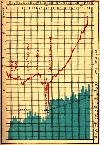
|
Figure 8. Cyanotic attacks in a weakling due to
under-feeding. The blue columns, which represent the daily
amount taken by the infant, do not attain the interrupted
line, which indicates the minimum amount required by an
infant of this weight. The attacks ceased when then infant
was adequately fed.
|
|
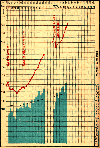
|
Figure 9. Attacks of cyanosis disappear immediately a
weakling receives sufficient nourishment. The blue columns
indicate the quantities of milk taken per day. The
interrupted line shows the minimum required.
|
|
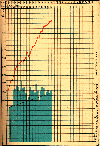
|
Figure 10. Weakling taking excess of milk and increasing
in weight at an abnormal rate. Digestive problems arise, and
disappear only when the daily allowance approaches the
normal. The interrupted line indicates the normal, the blue
columns the actual amount taken each day.
|
|
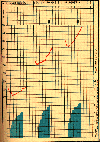
|
Figure 11. The blue columns indicate the quantities of
milk which ought to be taken each day during the first ten
days of life by (1) Infants weighing less than 1800 grams;
(2) Infants weighing between 1800 and 2200 grams; (3)
Infants weighing between 2200 and 2500 grams.
|
|
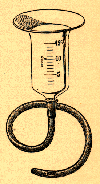
|
Figure 12. Graduated apparatus for gavage.
|
|
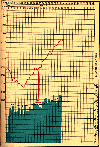
|
Figure 13. Infant taking insufficient milk. It scarcely
grows, and remains stationary from the nineteenth to the
twenty-third day. The curve becomes normal on increasing the
amount of milk. The blue columns represent the quantities of
milk taken each day; the interrupted line the average amount
required by the infant.
|
|
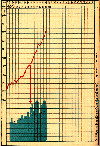
|
Figure 14. A weakling ought to take, in general, a
quantity of milk equal, or a little superior to, one-fifth
of its body-weight. This average amount is represented by
the interrupted black line. The quantity actually taken per
day is indicated by the blue columns. Curve taken from day
to day.
|
|
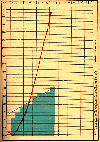
|
Figure 15. A weakling ought to take, in general, a
quantity of milk equal, or a little superior to, one-fifth
of its body-weight. This amount is represented by the
interrupted black line. The blue columns represent the
average quantity of milk taken daily during each week. Curve
taken from week to week.
|
|
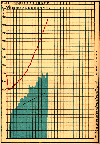
|
Figure 16. Weakling who took the first of the milk
flowing from the breast, a milk, consequently, poor in
butter. He absorbed a quantity which greatly exceeded
one-fifth of his body-weight. Blue columns = daily allowance
of milk. Interrupted line = one-fifth of body weight.
|
|
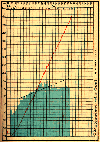
|
Figure 17. Weakling who, suckled by his wet-nurse after
she had given the breast to her own infant, took a milk very
rich in butter, and absorbed a quantity inferior to
one-fifth of his body weight. Blue columns represent the
daily allowance of milk. The interrupted black line
corresponds to one-fifth of the body-weight.
|
|
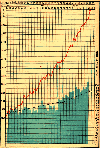
|
Figure 18. Weakling suckled successively by three
wet-nurses, A, B, and C, the quality of whose milk
differed. From the first, A, he took less, from the second,
B, and from the third, C, more than the amount corresponding
to one-fifth of his body weight. With A his weight rapidly
increased, with B it remained stationary, and with C it
again increased. The blue columns indicate the quantities of
milk taken per day. The black line corresponds to one-fifth
of the infant's body weight.
|
|
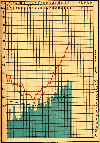
|
Figure 19. Weakling brought with diarrhoea. Treated by
dieting. His weight began to increase as soon as the stools
became yellow. He was then allowed to take the normal
quantity, which corresponds to a little more than one-fifth
of the body-weight.
|
|
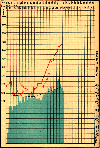
|
Figure 20. Enteritis. As soon as the stools became yellow
the infant's weight began to increase.
|
Return to The Nursling Contents Page
Created 1/30/97 / Last modified 1/30/97
Copyright © 1998 Neonatology on the Web / webmaster@neonatology.net












